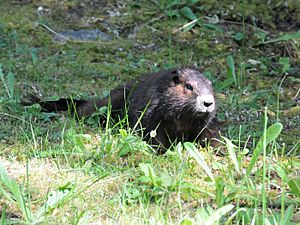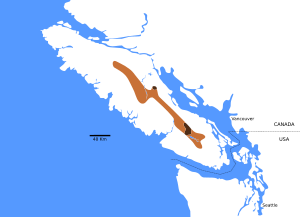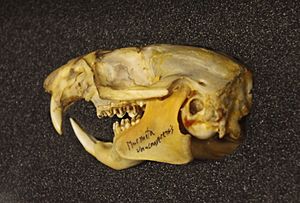Vancouver Island marmot facts for kids
Quick facts for kids Vancouver Island marmot |
|
|---|---|
 |
|
| In Alberni-Clayoquot Regional District, British Columbia, Canada | |
| Conservation status | |
| Scientific classification | |
| Genus: |
Marmota
|
| Species: |
vancouverensis
|
 |
|
The Vancouver Island marmot (Marmota vancouverensis) is a special type of marmot. It lives only in the high mountains of Vancouver Island, British Columbia, Canada. These marmots are quite large compared to other marmots and most other rodents. Marmots are the biggest members of the squirrel family. Adult Vancouver Island marmots can weigh from 3 to 7 kilograms (about 6.6 to 15.4 pounds). Their weight changes depending on their age and the time of year.
Even though they naturally live only on Vancouver Island, some Vancouver Island marmots now live in special breeding centers across Canada. They also live in some areas on Vancouver Island where they had disappeared in the 1990s. This is thanks to a special recovery program. This program helps prevent them from becoming extinct and aims to bring back healthy wild populations. Because of these efforts, the number of wild marmots grew from fewer than 30 in 2003 to about 250–300 by 2015.
Contents
What Does a Vancouver Island Marmot Look Like?
The Vancouver Island marmot looks and acts much like other marmots that live in mountains. However, you can easily tell this species apart from others. It has rich, chocolate-brown fur with bright white patches. No other marmot species naturally lives on Vancouver Island.
As its name suggests, this marmot lives only on Vancouver Island. Scientists believe it evolved quickly after the ice age ended about 10,000 years ago. The Vancouver Island marmot is different from other marmot species. It has unique features in its body, genes, behavior, and how it lives in its environment.
An adult Vancouver Island marmot is usually 56 to 70 centimeters (about 22 to 28 inches) long. This measurement is from its nose to the tip of its tail. Their weight changes a lot during the year. For example, an adult female might weigh 3 kilograms (6.6 pounds) when she wakes up from hibernation in late April. By late September or October, before hibernation, she might weigh 4.5 to 5.5 kilograms (10 to 12 pounds). Adult males can be even bigger, sometimes weighing over 7 kilograms (15.4 pounds). Marmots usually lose about one-third of their body weight during the six-and-a-half months they hibernate in winter.
Life Cycle and Where They Live
Like all marmots, Vancouver Island marmots live in burrows, which are underground tunnels. They only eat plants. Vancouver Island marmots have been seen eating over 30 different types of plants. In early spring, they mostly eat grasses. Later in the summer, they switch to plants like lupines.
Marmots hibernate for different lengths of time. This depends on where they live and the weather each year. Wild Vancouver Island marmots hibernate for about 210 days a year on average. This is usually from late September or early October until late April or early May. Marmots in zoos or breeding centers usually hibernate for shorter periods.
Vancouver Island marmots typically start having babies when they are three or four years old. Some have been seen breeding as young as two years old. They breed soon after they wake up from hibernation. Pregnancy is thought to last about 30–35 days. On average, a mother marmot has 3-4 pups in a litter. The young pups usually come out of the burrow for the first time in early July.
Scientists have been counting marmots since 1979. They have tried to cover different parts of Vancouver Island. Suitable meadows for marmots are rare on the island. This is compared to nearby areas in British Columbia or Washington State. This lack of good habitat is thought to be why this marmot species is so rare. Most marmots live above 1,000 meters (about 3,300 feet) in meadows that face south to west. It is believed that their numbers grew during the 1980s. Some natural meadows stay clear of trees because of snow and occasional avalanches or fires.
Why Are They Endangered?
There are many reasons why the number of marmots has gone down. Over thousands of years, changes in climate have caused the open mountain habitats to grow and shrink. More recently, weather patterns and changes in the landscape have affected their numbers.
One big change is clearcutting forests at lower elevations. This likely changed how young marmots move around. Young marmots usually leave the mountain meadows where they were born. They travel through lowland forests and valleys to find other meadows. However, clearcutting has created new open areas that marmots can use as habitat. The problem is that these man-made habitats quickly grow back into forests, making them unsuitable after a few years. One study found that these clearcut areas act like a "trap" for marmots. In these areas, their chances of having babies and surviving long-term are too low.
A study in 2005 suggested that the main reason for the recent decline was predators. These predators became more common because of forestry and changes in hunting patterns. The main animals that hunt Vancouver Island marmots include golden eagles (Aquila chrysaetos), cougars (Puma concolor), and wolves (Canis lupus).
The big drop in marmot numbers might also be due to something called the Allee effect. This idea suggests that social animals need a certain number of individuals to survive. This is because they rely on group activities, like warning each other about predators. If their numbers fall below this needed amount, their population can quickly decline. Some scientists think that marmots learn some of their group behaviors. So, if they lose this "culture," they might become more solitary and fight instead of working together.
The endangered Vancouver Island marmot is still one of the rarest mammals in the world. In 1997, there were so few marmots on Vancouver Island that experts decided to capture some. This was a bold step to create a "genetic lifeboat" and save the species. The first marmots went to the Toronto Zoo in 1997. Soon after, the Calgary Zoo and the Mountainview Conservation and Breeding Centre in Langley, BC, also joined the effort. The Marmot Recovery Foundation also built a special marmot facility on Mt. Washington, Vancouver Island. This helps with breeding marmots in captivity and getting them ready to be released into the wild. The main goal was to raise marmots so they could eventually return to their natural homes.
In 1998, a new way to help species recover began. It involved the government, private companies, and people who donated money. A count in late 2003 found only 21 wild marmots on Vancouver Island. After this, marmots were released from captivity in different places to help increase the wild population.
These marmots are still classified as endangered. The captive breeding program has steadily grown. By 2010, there were 130 marmots in captivity. Since 2000, 442 young marmots have been born and raised in captivity. Many marmots have been released into places like Strathcona Provincial Park, Mount Cain, Mount Washington, and other mountains to the south. From 2003 to 2010, the Marmot Recovery Foundation and the British Columbia Ministry of Environment released 308 marmots back into the wild. More releases are planned for the future to help the wild population grow. In 2010, the wild population was estimated at 250–300 marmots, and by 2013, it was 350–400.
Marmot Relatives
Scientists have studied the genes of the Vancouver Island marmot. They found that its closest relatives are the hoary marmot (Marmota caligata) and the Olympic marmot (Marmota olympus). There is some discussion among scientists about which of these two mainland species is most closely related to the Vancouver Island marmot. They also debate when marmots first arrived on the island. The differences in their DNA are small. In 2009, researchers Nagorsen and Cardini looked at museum specimens. They found big physical differences between the species. These differences can only be explained by rapid evolution in a relatively isolated island environment.
A Special Symbol
- Because they are endangered, Vancouver Island marmots have become a symbol for conservation in British Columbia.
- Mukmuk, a "sidekick" to the three official mascots for the 2010 Winter Olympics and Paralympics, is shown as a Vancouver Island marmot.
- The Victoria Royals hockey team's mascot, "Marty the Marmot," is based on the Vancouver Island marmot. The team chose this mascot to show how important the species is to the Vancouver Island region. The marmot was also the former mascot of the now-closed Victoria Salmon Kings hockey team.
Images for kids
See also
 In Spanish: Marmota de Vancouver para niños
In Spanish: Marmota de Vancouver para niños




